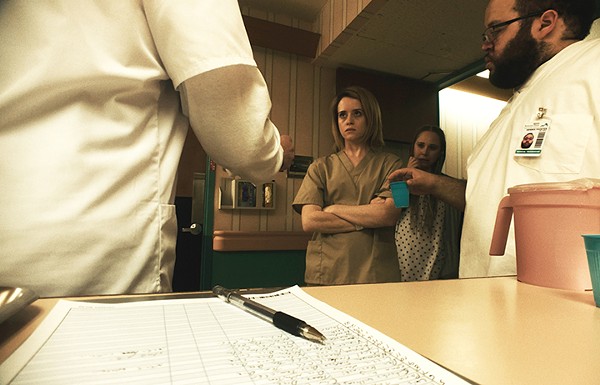Unsane
Unsane, 2018, 2 stars
Soderbergh phones it in
From The Orlando Weekly, March 23, 2018
Director Steven Soderbergh is known for experimentation, and for that he deserves commendation. Nevertheless, his latest exercise has landed with a thud or, more fittingly, with whatever sound an iPhone makes when hitting the ground, as that’s the tool he used to shoot his new movie.
Arguably his first true psychological horror/thriller, Unsane is the story of Sawyer, a young woman fresh to Philly. She relocated there from Boston to get away from David, a man who was stalking her. Yet she still hallucinates him in impossible places: at her work, on the street, in the faces of strangers.
“I’m alone in a strange city, and I never feel safe,” she confesses.
So, naturally, she reaches out to a psychologist. But instead of receiving proper treatment, she finds herself mistakenly committed to a mental institution for 24 hours (or longer if she misbehaves). That might sound preposterous, but it’s actually easy to swallow once an explanation is proffered. (Hint: As with most medical issues in this country, it involves insurance abuse.) What is more difficult if not impossible to imbibe is the (real or imagined?) role of her stalker in this tragedy of errors.
As Sawyer, Claire Foy (The Crown) is excellent and does her best to make us forget the flaws of Jonathan Bernstein and James Greer’s script. Alert ears might notice some lapses in rhoticity (those American “R” sounds) induced by her native English dialect, but she otherwise does exactly what Soderbergh asks of her, and then some. As the stalker, Joshua Leonard (The Blair Witch Project) is suitably creepy, as is Juno Temple (Atonement, Wonder Wheel). Oh, and watch for Matt Damon in a throwaway role.
Another supporting performer is the aforementioned phone. Specifically, it’s an iPhone 7 Plus. And though Soderbergh uses 4K resolution (comparable to some of the best professional, digital cameras), there’s no denying that the movie looks odd. Still shots, which he uses extensively, are somewhat attractive, but tracking shots are deplorable, with at least one appearing to glitch, as if the projected frame rate is different from the frame rate he used to shoot the movie. (He at least avoids shaky, handheld visuals, so you can leave your Dramamine at home.)
Lighting is also dreadful, except for a strangely attractive, eerie blue that permeates the night scenes. Similarly intriguing – in a love-it-or-hate-it way – are the boxy aspect ratio (1.56:1) and the enormous depth of field. In other words, foreground and background objects are in focus at the same time. Uncommon in today’s cinema, that technique was used, to brilliant effect, in older films, notably Citizen Kane. But Unsane is no Kane, and Soderbergh’s creation comes across as cheap and flat – not just in picture, but in story, pacing and scoring (or lack thereof).
For all the visual and story oddities, there are moments when the movie successfully induces dread and claustrophobia. But it never approaches the level of a nightmare and comes partially unhinged toward the end thanks to the absence of a satisfactory, imaginative twist.
The best one can say about Soderbergh’s failed experiment is it’s probably the most attractive film ever shot with a phone. So depending upon your take on technology, Unsane either marks the beginning of a new, noble democratization of the movie industry or the first sign of the cinematic apocalypse.
© 2018 Orlando Weekly / MeierMovies, LLC
